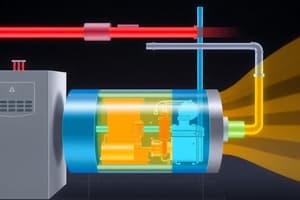Podcast
Questions and Answers
Where is heat rejected by the refrigerant in a refrigeration cycle?
Where is heat rejected by the refrigerant in a refrigeration cycle?
- Cold chamber
- Condenser (correct)
- Hot chamber
- Evaporator
What happens to the refrigerant as it passes through the nozzle in a refrigeration cycle?
What happens to the refrigerant as it passes through the nozzle in a refrigeration cycle?
- It remains a liquid state but at a lower pressure.
- It remains as a liquid but with an increased pressure.
- It solidifies due to the decrease in temperature.
- It expands into a low-pressure area, reducing in pressure and temperature, turning into a gas. (correct)
What does the second law of thermodynamics deal with?
What does the second law of thermodynamics deal with?
- Heat (correct)
- Momentum
- Energy
- Work done
What percentage of the energy is extracted from the cold reservoir if the coefficient of performance (COP) of a refrigerator is 5?
What percentage of the energy is extracted from the cold reservoir if the coefficient of performance (COP) of a refrigerator is 5?
If a working substance in a heat engine absorbs 3000 J from the hot reservoir and 2250 J are wasted per cycle, what is the efficiency of the engine?
If a working substance in a heat engine absorbs 3000 J from the hot reservoir and 2250 J are wasted per cycle, what is the efficiency of the engine?
Where does the refrigerant absorb heat at constant pressure in a refrigerator cycle?
Where does the refrigerant absorb heat at constant pressure in a refrigerator cycle?
What happens to a diamagnetic material when placed in a uniform magnetic field?
What happens to a diamagnetic material when placed in a uniform magnetic field?
Which property is conserved according to the first law of thermodynamics?
Which property is conserved according to the first law of thermodynamics?
What type of material is diamagnetic?
What type of material is diamagnetic?
How does a refrigerator release heat to the air outside in a refrigeration cycle?
How does a refrigerator release heat to the air outside in a refrigeration cycle?
In a given thermodynamic process on an ideal gas where dW 0 and dQ 0, what happens?
In a given thermodynamic process on an ideal gas where dW 0 and dQ 0, what happens?
What does the coefficient of performance of a refrigerator measure?
What does the coefficient of performance of a refrigerator measure?
What is the purpose of a compressor in a refrigeration cycle?
What is the purpose of a compressor in a refrigeration cycle?
What is the external work done on the working substance in a refrigerator cycle if 20% of the energy is extracted from the cold reservoir?
What is the external work done on the working substance in a refrigerator cycle if 20% of the energy is extracted from the cold reservoir?
Which law of thermodynamics relates to the extraction of energy from the cold reservoir in a refrigerator?
Which law of thermodynamics relates to the extraction of energy from the cold reservoir in a refrigerator?
What is the coefficient of performance (COP) of a refrigerator when 20% of the energy extracted from the cold reservoir is used as external work?
What is the coefficient of performance (COP) of a refrigerator when 20% of the energy extracted from the cold reservoir is used as external work?
In a refrigeration cycle, what type of process occurs when the condenser temperature decreases?
In a refrigeration cycle, what type of process occurs when the condenser temperature decreases?
How does the efficiency of a heat engine relate to the coefficient of performance (COP) of a refrigerator?
How does the efficiency of a heat engine relate to the coefficient of performance (COP) of a refrigerator?
Flashcards are hidden until you start studying
Study Notes
Refrigeration Cycle
- Heat is rejected by the refrigerant in the condenser.
- The refrigerant expands and its pressure and temperature decrease as it passes through the nozzle.
Thermodynamics
- The second law of thermodynamics deals with the direction of spontaneous processes.
- The coefficient of performance (COP) of a refrigerator measures its efficiency in transferring heat from the cold reservoir to the hot reservoir.
Energy Efficiency
- If the COP of a refrigerator is 5, 20% of the energy is extracted from the cold reservoir, and 80% is used as external work.
- The efficiency of a heat engine is 25% if it absorbs 3000 J from the hot reservoir and 2250 J are wasted per cycle.
Refrigeration Process
- The refrigerant absorbs heat at constant pressure in the evaporator.
- A refrigerator releases heat to the air outside through the condenser.
Magnetic Materials
- Diamagnetic materials are repelled by a uniform magnetic field.
Laws of Thermodynamics
- The first law of thermodynamics states that energy is conserved.
- The second law of thermodynamics relates to the extraction of energy from the cold reservoir in a refrigerator.
Thermodynamic Processes
- If dW = 0 and dQ = 0, the process is an isometric and adiabatic process.
- The COP of a refrigerator measures the ratio of heat transferred from the cold reservoir to the work input.
Compressor Function
- The purpose of a compressor in a refrigeration cycle is to increase the pressure and temperature of the refrigerant.
Work and Energy
- If 20% of the energy is extracted from the cold reservoir, 80% is used as external work.
Refrigerator Performance
- If the condenser temperature decreases, the refrigeration process becomes more efficient.
- The efficiency of a heat engine is inversely proportional to the COP of a refrigerator.
Studying That Suits You
Use AI to generate personalized quizzes and flashcards to suit your learning preferences.




